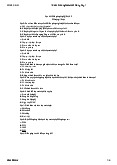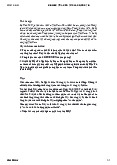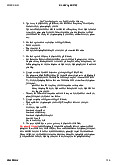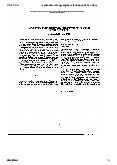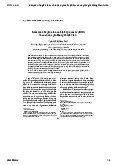






Preview text:
23:58 31/7/24 Pragmatic
From a formal point of view, pronouns are, as we demonstrated in Chapter the 5,
paradigm examples of expressions used by speakers to refer to 'given' entities.
Pronouns are typically uttered with low pitch in spoken discourse and, as such,
are types of referring expressions which, in Chafe's terms (1976), are
phonologically and lexically 'attenuated'. Because of their lack of 'content', they
have become the crucial test-case items for any theory of reference. After all, to what does the expression
refer, in isolation? The fact that there it is no
reasonable answer to this question has led many linguists to suggest that a pronominal such as is not actually it
a referring expression, but can only be used
co-referentially, that is, within a text which also includes a full nominal expression.
The relationship between the full nominal expression and the pronominal
expression is then described as an antecedent-anaphor relation, as we have
noted already in section 6.I.I. The occasional use of pronouns in situations such as
(35) is treated as an example of deixis treated as an example of deixis and
virtually dimissed as unrealated
to the more serious business of determining how anaphoric prondminals receive
their interpretation. (An exception to this general tendency is Lyons (1979) who
argues, convincingly, that the anaphoric use is derived from the more basic
deictic use of pro-forms in the language.)
35) (A large dog approaches A and B. A says to B:) I hope it's friendly.
In other treatments, the use of
in (35) is described as an example of it
'pragmatically controlled anaphora' (cf. Hankamer & Sag, 1977; Partee, 1978;
Yule, 1979). In this use of the term 'anaphora', the requirement of an antecedent
expression in the text is not considered crucial. In this sense, 'anaphora' covers
any expression which the speaker uses in referring on the basis of which the
hearer will be able to pick out the intended referent given certain contextual and
co-textual conditions. For obscure historical reasons, the term 'anaphora', as it is
generally used, is restricted almost exclusively to 'pronominal referring
expressions'. We will follow this practice throughout this section. One other aspect
of the treatment of pronouns, or anaphors, should be noted, because it
determines the nature of the discussion which follows. Both theoretical and
experimental work on pronouns has concentrated almost exclusively on the
interpretation, and not the production, of pronouns. This probably reflects the
general fact that, as Tyler (1978: 227) observes, 'most of the linguistic literature is
written from the hearer's point of view'. Thus, in our consideration of existing
views and analyses of pronouns in discourse, we shall be primarily interested in
determining what is required in an adequate account of the interpretation of pronouns in discourse.
Đoạn văn này thảo luận về vai trò của đại từ trong ngôn ngữ, đặc biệt là cách chúng được sử dụng để
tham chiếu đến các thực thể đã được đề cập trước đó.
1. Đại từ như là biểu thức tham chiếu:
Đoạn văn bắt đầu bằng cách xác định đại từ là ví dụ điển hình về cách người nói tham chiếu đến những thứ
đã được đề cập trong cuộc trò chuyện ("thực thể đã cho").
Đại từ thường được nói với ít trọng âm hơn (giọng thấp).
Do thiếu ý nghĩa vốn có, đại từ là yếu tố quan trọng để kiểm tra các lý thuyết về tham chiếu trong ngôn ngữ.
2. Thử thách với đại từ "it":
Ví dụ sử dụng đại từ "it" để chỉ một con chó chưa được đề cập trước đó (câu 35) tạo ra một vấn đề. about:blank 1/7 23:58 31/7/24 Pragmatic
Theo quan điểm truyền thống, đây được gọi là "deixis" - sử dụng đại từ để chỉ một thứ mới trong tình huống,
không tham chiếu đến một thứ đã được đề cập.
Nhiều nhà ngôn ngữ học cho rằng đại từ như "it" chỉ có thể được sử dụng "đồng tham chiếu", nghĩa là chúng
cần một cụm danh từ đầy đủ được đề cập trước đó (tiền thân) để có nghĩa.
Đại từ và cụm danh từ có "mối quan hệ tiền thân - đại diện", như đã thảo luận ở phần trước.
3. Deixis so với đại diện được kiểm soát thực dụng:
Một số nhà ngôn ngữ học (Lyons, 1979) cho rằng việc sử dụng đại diện (tham chiếu về phía sau) thực sự bắt
nguồn từ việc sử dụng deixis (chỉ ra một thứ mới) cơ bản hơn.
Những người khác (Hankamer & Sag, 1977; Partee, 1978; Yule, 1979) coi việc sử dụng "it" trong câu 35 là
một ví dụ về "đại diện được kiểm soát thực dụng".
Theo quan điểm này, ý nghĩa của đại từ phụ thuộc vào ngữ cảnh và khả năng của người nghe để hiểu đối
tượng được đề cập (con chó) ngay cả khi không có tiền thân rõ ràng.
Theo cách sử dụng truyền thống, "đại diện" dùng để chỉ đại từ tham chiếu về phía sau, nhưng ở đây nó được sử dụng rộng rãi hơn.
4. Tập trung vào giải thích, không phải sản xuất:
Các nghiên cứu về đại từ chủ yếu tập trung vào cách người nghe giải thích chúng, không phải cách người nói chọn chúng.
Điều này phản ánh xu hướng chung trong ngôn ngữ học là phân tích ngôn ngữ từ góc độ người nghe.
5. Mục tiêu của tác giả:
Bằng cách xem xét các quan điểm hiện có, tác giả hướng đến mục tiêu xác định những gì cần thiết cho một
lời giải thích hợp lý về cách đại từ được giải thích trong ngôn ngữ.
Nhìn chung, đoạn văn này làm nổi bật sự phức tạp của đại từ. Nó tranh luận về việc liệu đại từ như
"it" có thể tham chiếu mà không có tiền thân rõ ràng hay không và nhấn mạnh vai trò của ngữ cảnh
và sự hiểu biết của người nghe trong việc giải thích đại từ. about:blank 2/7 23:58 31/7/24 Pragmatic
6.3. I Pronouns and antecedent nominals
It is initially quite a plausible notion that the interpretation of the pronoun in (36)
is arrived at by a simple process of replacing with it
my hair, as in (36a).
(36) I've just had my hair curled and it looks windblown all the time.
(36a) My hair looks windblown all the time.
Such a view has been described already in section 6.1.2, and is normally
expressed in terms of the pronominal 'referring back' to its antecedent nominal
(cf. Carpenter &Just, 1977a: 236), or in terms of the pronominal 'substituting for'
the antecedent (cf. Tyler, 1978: 336). This general view has been characterised as
the 'pronominal surrogate hypothesis' by McKay & Fulkerson (1979). They
demonstrate, in an experimental situation, that it is not the case that 'the nature
of the antecedent completely determines the interpretation of the pronoun'
(1979: 661). We attempted to show with Halliday & Hasan's six cooking apples -
them example, (IS), that the substitution concept was misleading. We argued that
if a 'change of state' predicate is attached to a nominal expression, then
subsequent pronominals must be interpreted in terms of that predicate. The
experimental work of Garvey et al. (1975) and Caramazza et al. (1977), using
what they call 'verbs of implicit causality', lends support to this argument.
We might suggest, then, that a better analysis of it in extract (36) would involve
not only the antecedent nominal expression, but also the accompanying
predicate, as shown in (36b). (Throughout this discussion we indicate only the
salient predicates required in interpretation. There are, of course, many other
predicates which could be listed each time a pronoun is represented in this way.) (36b
My hair which I've just had curled looks windblown all the time. )
Notice that the nature of the entity to which looks windblown applies is different in (36b) from that in (36a).
In support of this view, there is Chastain's observation that, in some discourses,
'the descriptive content of the anaphorically connected singular terms
accumulates over time' (1975: 232) (see also the full representations listed for
discourse anaphors in Webber, 1978).
Đoạn văn giải thích về đại từ và danh từ chỉ trước
Đoạn văn này thảo luận về đại từ và cách chúng liên hệ với những từ được đề cập trước đó trong câu (danh từ chỉ trước).
Tóm tắt các điểm chính:
Quan điểm thay thế đơn giản (sai): Ban đầu, có vẻ như việc thay thế đại từ bằng danh từ chỉ trước của
nó là đủ để hiểu. (ví dụ: "Tôi vừa uốn tóc" -> "Tóc tôi trông gió thổi mọi lúc").
Hạn chế của việc thay thế: Quan điểm này (được gọi là giả thuyết đại từ thay thế) có sai sót. Đại từ có
thể không chỉ đơn giản là thay thế cho toàn bộ cụm danh từ.
Xem xét vị ngữ: Các tác giả lập luận rằng cụm động từ mô tả danh từ (vị ngữ) cũng quan trọng để giải
thích đại từ. (ví dụ: "uốn" trong "Tôi vừa uốn tóc").
Ví dụ: Trong câu "Tôi vừa uốn tóc và nó trông gió thổi mọi lúc", "nó" không chỉ đề cập đến "tóc của
tôi" nói chung. Nó đề cập đến "tóc của tôi trong trạng thái được uốn".
Bằng chứng hỗ trợ: Các nhà nghiên cứu khác quan sát thấy rằng ý nghĩa của đại từ có thể tích lũy theo
thời gian trong một cuộc trò chuyện, xem xét các mô tả trước đây về danh từ mà chúng đề cập. about:blank 3/7 23:58 31/7/24 Pragmatic
Nói đơn giản: Đại từ không chỉ thay thế danh từ. Chúng liên kết trở lại ý tưởng đầy đủ của danh từ, bao
gồm những gì đã được nói về nó trước đó (cụm động từ mô tả nó). Điều này rất quan trọng để hiểu đầy
đủ ý nghĩa của đại từ.
6.3.2 Pronouns and antecedent predicates
The representation proposed in (36b) for the pronoun in (36) may seem to make
the information carried by a pronoun unnecessarily complex. There is evidence,
however, that speakers' use of pronouns is indeed influenced by the predicates
attached to antecedent nominals. Extracts (37) and (38) are presented as two examples.
(37) There's two different ladies go up to the whist and both have a wig and they're most natural.
(38) Even an apprentice can make over twenty pound a week and they don't get much tax [taken] from that.
The correct interpretation of the reference of they in (37) depends on the hearer's
understanding that there are two wigs and not one, as the nominal antecedent (a
wig) by itself would suggest. In (38), there is a similar problem, with a singular
nominal antecedent and a plural pronoun. By itself, the expression an apprentice
might be interpreted as introducing a particular individual into the discourse.
However, when interpreted in the context of the predicate can make over twenty
pound a week, it has to be taken, not as a particular individual, but as any
individual from a set of individuals to whom the lexical expression apprentice can
be applied. The choice of subsequent pronoun (e.g. he or they) then simply
reflects the speaker's perspective on whether he is considering a typical individual
or a set of such individuals. The speaker of (38) chooses the latter. Examples (37)
and (38) present a grammatical mismatch in terms of number agreement
between antecedent nominal and subsequent pronoun. Extracts (39) and (40),
both taken from descriptions of traffic accidents, seem to present a mismatch in terms of gender agreement.
(39) There's a car going up the road and he comes to a crossroads.
(40) The second car hasn't got time to avoid the person who swerved away to
avoid the car that was pulling out and he hits it.
In example (39), the hearer is clearly required to infer that a car moving along a
road must have a driver and that it is this inferred driver who the he is used to
refer to. Example (40) presents a more complex problem. Despite the presence of
both a human and a non-human antecedent for he and it, the most natural
interpretation of what happened requires us to match the grammatically 'human'
pronoun with the 'non-human' antecedent, and the 'non-human' pronoun with the
'human' antecedent. Such assignments appear to be made on the basis of the
roles of the two referents with regard to an antecedent predicate and a
consequent predicate (i.e. X hasn't got time to avoid Y and X hits Y).
Whatever the proper explanation for the natural assignment in (40), it certainly
does not seem to be on the basis of an antecedent nominal / anaphoric
pronominal substitution relationship
Đoạn văn này lập luận rằng đại từ chịu ảnh hưởng bởi nhiều yếu tố hơn là chỉ danh từ mà chúng đề cập đến
(danh từ chỉ trước). Nó đưa ra bằng chứng cho thấy người nói tính đến toàn bộ cụm từ mô tả danh từ (vị
ngữ) khi sử dụng đại từ.
Dưới đây là tóm tắt các điểm chính:
1. Không chỉ thay thế đơn giản: Cách đoạn văn thể hiện đại từ trong (36b) có vẻ phức tạp, nhưng nó nhấn
mạnh rằng nghĩa của "chúng" phụ thuộc vào toàn bộ cụm từ "đội tóc giả" (không chỉ "tóc giả"). about:blank 4/7 23:58 31/7/24 Pragmatic
2. Ví dụ về sự không khớp: Đoạn văn sử dụng các câu có sự không khớp giữa đại từ và danh từ chỉ trước:
Câu (37): "chúng" đề cập đến "hai bộ tóc giả" chứ không phải một (số ít so với số nhiều).
Câu (38): "chúng" đề cập đến "một người học việc" (được hiểu là một nhóm, không phải một người).
3. Tập trung vào vị ngữ: Những sự không khớp này cho thấy người nói tính đến vị ngữ khi chọn đại từ.
Trong câu (38), "có thể kiếm được hơn hai mươi bảng một tuần" cho thấy "người học việc" được hiểu là bất
kỳ người học việc nào, chứ không phải một người cụ thể.
Sự không khớp phức tạp hơn: Câu (39) và (40) cho thấy sự không khớp về giới tính:
(39): "anh ấy" đề cập đến người lái xe của một "chiếc ô tô".
(40): "anh ấy" đề cập đến một "chiếc ô tô" và "nó" đề cập đến một "người".
Hiểu dựa trên vai trò: Mặc dù những câu này có sự không khớp về giới tính, người nghe vẫn hiểu chúng.
Sự hiểu biết này đến từ vai trò của các danh từ trong câu (ví dụ, ai là người tránh ai trong tai nạn).
Kết luận: Việc giải nghĩa đại từ không chỉ đơn thuần là thay thế một danh từ. Người nói tính đến toàn bộ
cụm từ mô tả danh từ (vị ngữ) và vai trò của các danh từ để chọn đại từ phù hợp nhất.
Nói một cách đơn giản hơn, đại từ không chỉ thay thế cho danh từ. Người nói chọn đại từ dựa trên toàn bộ ý
nghĩa của cụm danh từ, bao gồm cả cụm động từ mô tả nó và vai trò của các danh từ trong tình huống đó.
Pronouns and 'new' predicates
In considering the basis for determining referents from pronouns, we have
concentrated so far on examples where some type of nominal antecedent does
exist in the discourse prior to the occurrence of the pronoun. The inadequacy of
the substitution approach is even more apparent in those situations where a
pronoun occurs in a discourse with no antecedent nominal at all. It may be of
interest to consider such examples in terms of their 'given/ new' structure, as
described in Chapter 5 . That is, the speaker may structure his message in such a
way that some 'new' information is attached to a 'given' element (i.e. a pronoun),
intending to provide the hearer with a 'given / new' interpretive procedure.
However, the hearer may have to reverse that procedure and use the 'new'
information to decide what the 'given' referent must have been. The use of the
pronoun she near the end of extract (41) provides one example of this process.
(41) (Talking about the First World War) I used to go about with a chap- I don't
know whether he's still alive now or not -but -there was nine-ten-eleven in the family altogether-two girls
-and nine boys- and she lost eight sons one after the other
In example (41) there is no linguistic expression which could be treated as the
direct antecedent for she. Of course, we can propose that if the speaker is talking
about a family and there is a female referent (she) who lost eight sons, then
we can infer that it is 'the mother' the speaker is referring to. Notice that, if the
hearer does follow this procedure, then he is using 'new' information to determine a 'given' referent. about:blank 5/7 23:58 31/7/24 Pragmatic
Example (41) raises a serious problem for any analysis of pronouns as conveying
'given' information which depends on a referential assignment via information in
the preceding discourse. Unfortunately, one of the most influential views of how
we process pronouns in discourse, the 'given - new strategy' of Clark & Clark
(1977), is based on a dependency of this sort. In the following extracts from
conversational discourse, the examples of pronouns used to realise 'given'
information should 'serve as an address directing the listener to where "new" information should be stored'
(Haviland & Clark, 1974: 520).
(42) one of our main jobs in the Botanics is writing on the flora of Turkey + they . . .
(43) I have a cousin who's very deaf + and she can't hear Jessie + because Jessie
speaks too loudly + you see she .. .
(44) Oh I was on the bus and + he ..
We think it should be obvious that in none of these fragments, (42)-(44), is there a
situation in which 'listeners can be confident that the given information conveys
information they can identify uniquely' (Clark & Clark, 1977: 92). Rather, there is,
on each occasion, more than one potential referent for the pronoun. The
interpretation of the reference of these pronouns depends on what is predicated
of them, and is not solely determined by information in the preceding discourse.
The reader can, of course, make predictions about the referential assignment of
these pronouns on the basis of extracts (42)-(44) alone. Those predictions can be
confirmed (or not) by consideration of the subsequent predicates, as shown in (42a- 44a).
(42a) one of our main jobs in the Botanics is writing on the flora of Turkey + they
don't have the scientists to do it.
In this example, it seems that the speaker has assumed that, if he is talking about
a country, he can refer to a group of people in that country without having to
assert explicitly that 'Turkey has people in it'. If that is a required inference on the
hearer's part, then it can only take place after the hearer has heard the 'new'
predicate attached to the pronoun they. We might also note that, if 'the people of
Turkey' are part of the extended domain of reference of an expression such as
Turkey, then yet another psycholinguistics processing claim regarding pronouns
is undermined. Sanford & Garrod (1981) claim that 'pronouns can never be used
to identify implied entities in the extended domain of reference'. Clearly can, as in
extract (42a) and again in (44a)
Extract (43a) exhibits a resolution problem similar to the one described in
example (40) earlier, where it is not a case of a missing antecedent, but of a
choice between competing antecedents.
(43a) I have a cousin who's very deaf + and she can't hear Jessie + because
Jessie speaks too loudly + you see she shouts at her
Given the 'new' predicate in (43a), the hearer can choose the most likely referent
for the she, probably on the basis of the 'roles' filled by the two participants in the situation.
(44.a) oh I was on the bus and + he didn't stop at the right stop
Just as a car involved in a car crash is most likely to have a driver, as in (39), so
too is a bus carrying passengers. It may be, of course, that there is only a limited
set of such 'situations' in which pronouns can be used to refer to implied entities.
If that is the case, then it is our job to characterise the limited set, rather than
describe the processing of pronouns as if the set did not exist (e.g. Clark & Clark, about:blank 6/7 23:58 31/7/24 Pragmatic
1977) or to claim that such processing never takes place (e.g. Sanford & Garrod, 1981).
Examples (42)-(44) have been presented as illustration of the fact that we need to
take 'new' predicates into account when assigning an interpretation to some
'given' elements, such as pronouns in discourse. These examples may also
provide support for a point made earlier in section 6.2.1, that speakers' and
hearers' representations of a discourse are unlikely to be perfect matches. If a
hearer has to construct, from what the speaker says, an interpretation of the most
likely intended referent, then interpreting pronouns may present special
problems. Speaker D, in the following conversational fragment, indicates (with his
question) the problem he is having with determining one of speaker C's intended referents.
(45) (both speakers are looking at a photograph in a book)
C: it's quite an interesting book actually + he was a surgeon and photographer + D: a surgeon and photographer?
C: the man who took the photographs D: oh I see I see
It may be, of course, that, unlike speaker D in extract (45), we do not always
indicate when we have failed to identify the speaker's intended referent. It is
difficult, however, to imagine what type of evidence (other than an indication by
one of the participants of confusion) we could reliably use to characterise such
potential failures on other occasions, e.g. in examples (37)-(44.). about:blank 7/7
